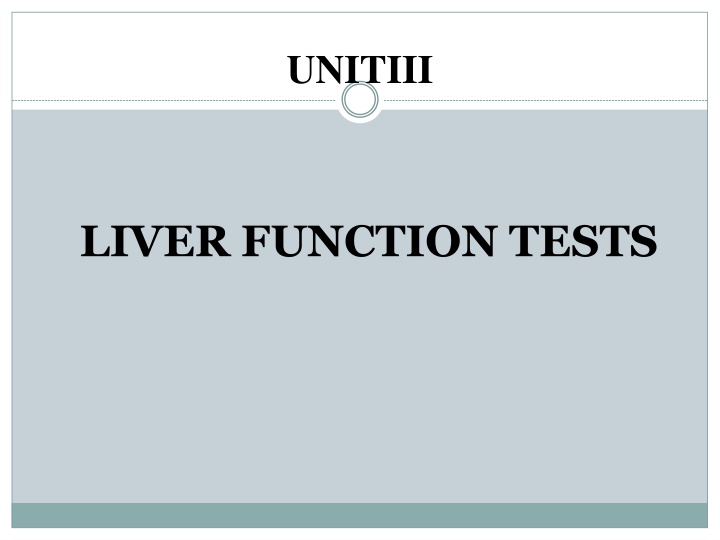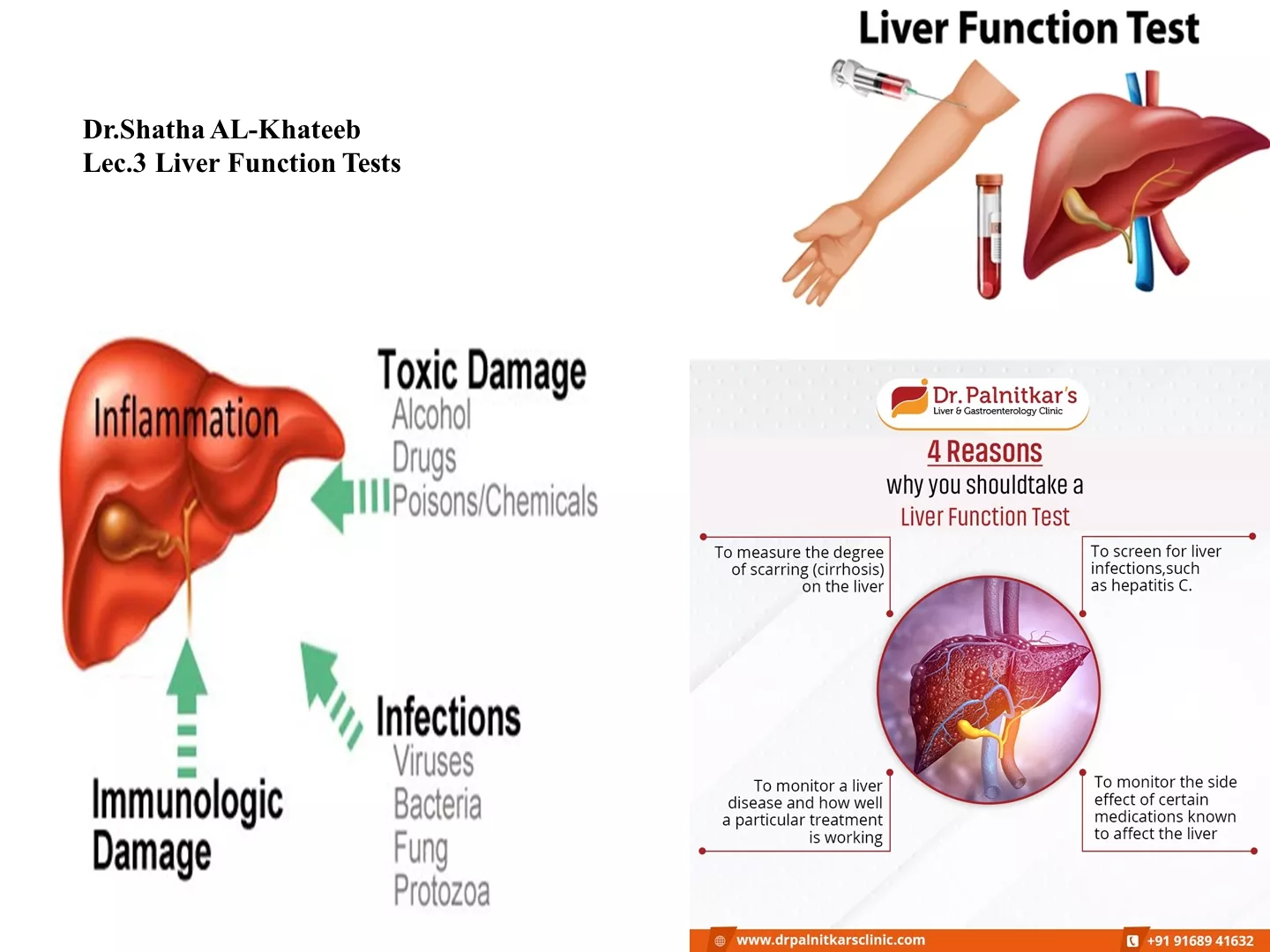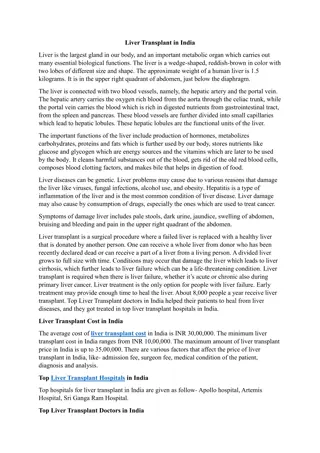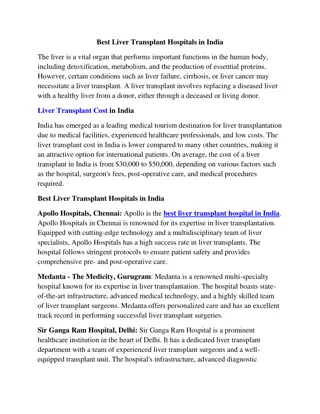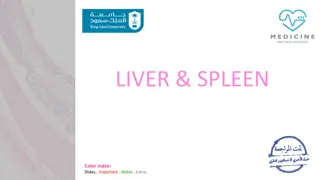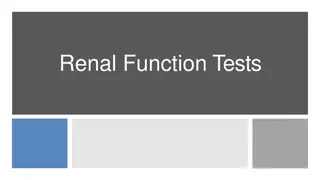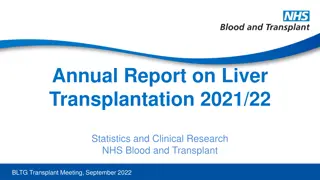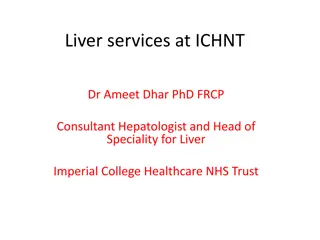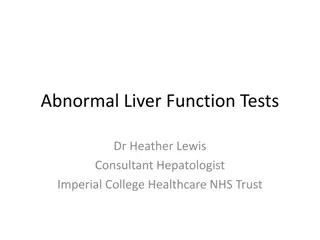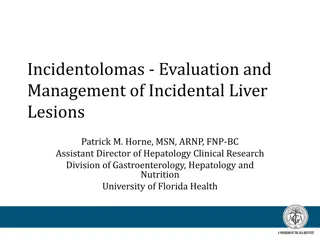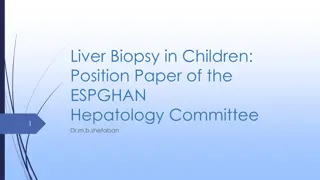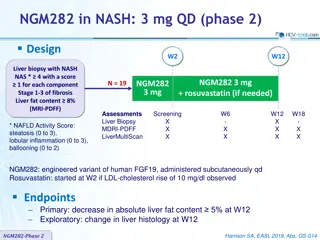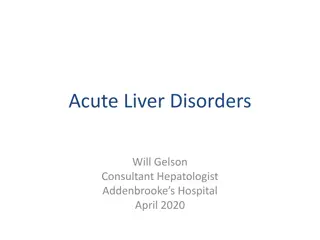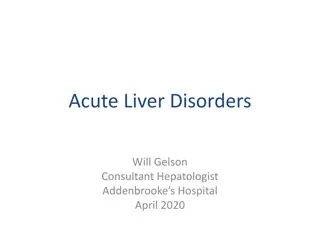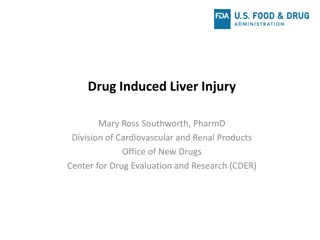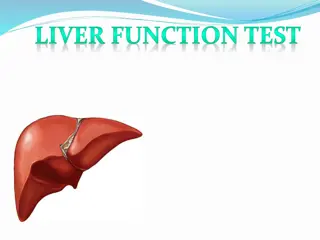LIVER FUNCTION TESTS
Each organ's biochemical functions rely on intact cellular structure. Liver function tests detect liver disease, distinguish types, gauge damage extent, and monitor treatment responses. The liver performs metabolic, excretory, protective, detoxification, hematological, and storage functions. Various tests evaluate excretory function, bile pigments, bile salt, bromosulphthalein, biosynthetic function, and detoxification capacity.
Download Presentation

Please find below an Image/Link to download the presentation.
The content on the website is provided AS IS for your information and personal use only. It may not be sold, licensed, or shared on other websites without obtaining consent from the author.If you encounter any issues during the download, it is possible that the publisher has removed the file from their server.
You are allowed to download the files provided on this website for personal or commercial use, subject to the condition that they are used lawfully. All files are the property of their respective owners.
The content on the website is provided AS IS for your information and personal use only. It may not be sold, licensed, or shared on other websites without obtaining consent from the author.
E N D
Presentation Transcript
UNITIII LIVER FUNCTION TESTS
Each organ of the body has to perform its biochemical functions Possible only when the cells of the organ are intact in structure and function Any abnormality in the tissue caused by exogenous or endogenous factors will seriously impair the organ function which influences the health of the organism Upon damage of tissue cellular content (specially enzymes) will be released in to serum and increases its level SGPT, SGOT, Amylase, Lipase etc
Some organ synthesizes biomolecules for serum Any functional abnormalities decreases serum level of that biomolecule Total protein, albumin, globulin Deficiency of any substrate or cofactor for synthesis pathway also leads to decreases biomolecule eg: HB Organ also perform abnormalities in tissue leads to increase serum level of biomolecule Bilirubin, Creatinine, Urea serum level of execratory function, any
LIVER FUNCTION TESTS Detect presence of liver disease Distinguish among different types of liver disease Gauge the extent of known liver damage Follow the response of treatment Do not suggest a specific diagnosis
Functions of Liver Metabolic function Execratory function Protective function and detoxification Haematological function Storage function
Tests for excretory function bile pigments bile salt bromosulphthalein
Tests for excretory function Bile pigments Bile salt Bromosulphthalein
Tests for Biosynthetic function Serum Albumin Serum Globulins Prothrombin time
Tests for detoxification capacity Hippuric acid synthesis
Tests for metabolic capacity Galactose tolerance
Tests based on serum enzymes derived from liver ALT (alanine transaminase) AST (aspartate transaminase) ALP (Alkaline phosphatase) 5- nucleotidase Gama- glutamyltranspeptidase (GGT)
Serum Bilirubin Bilirubin is a bile pigment, and is the excretory end product of heme degradation Conjugated in liver by glycosylation Excreted in bile Conjugated bilirubin : water soluble , so excreted by kidneys Unconjugated bilirubin : insoluble in water , bound to albumin in blood
Normal serum contains and conjugated bilirubin(20%) Horse: 1-2 mg/dl Cattle: 0.01-0.5 mg/dl Dog : 0.06-0.12 mg/dl unconjugated bilirubin(80%)
Test for serum bilirubin Van Den Bergh method- specific reaction to identify the increase in serum bilirubin (above the reference level) Bilirubin reacts with diazo reagent to produce coloured azo pigment .At pH 5 pigment purple Conjugated bilirubin gives purple color within 30 sec. this is referred as direct positive van den Bergh reaction Unconjugated bilirubin gives van den Bergh reaction within 30 min. after addition of methanol this is referred as indirect positive
Serum Bilirubin If serum contain both conjugated and unconjugated bilirubin then purple color produced immidiataly (direct positive) which further intesified by addition of alcohal (indirect Positive)- Biphesic reaction Indirect Positive- hemolytic jaundice Direct positive- obstructive jaundice Biphesic- hepatic jaundice
Unconj Conj In water In alcohol normal In bile In urine Absorption gut Diffusion into tissues Van den bergh insoluble soluble 0.2-0.9mg/dl Absent Always absent Absorbed Diffuses yellow colour Indirect + soluble soluble 0.1-0.4mg/dl Present Normally absent Not absorbed Doesn t diffuse Direct +
Bilirubin in urine Conjugated bilirubin , being water soluble is excreated in urine Unconjugated bilirubin , being water insoluble is not excreated in urine
Bromosulphalein test Bromosulphalein is a dye use to assess the excretory function of liver Non toxic dye excreted through bile within 45 min. Any impairment in liver increase retention time
Serum Albumin Synthesize by liver Normal : 3.5 5 g/dl Long half life :18 -20 days Because of slow turnover S.Albumin not a good indicator of acute/mild hepatic dysfunction Good indicator for chronic hepatic dysfunction Hypoalbuminemia chronic hepatic dysfunction cirrhosis Ascites protein malnutrition,
Serum Globulins Increased stimulation peripheral Reticulo-endothelial system when shunting of antigens past liver & impaired clearance by kupffer cells Gamma globulins B lymphocytes Alpha , beta globulins hepatocytes Increased gamma globulins CLD
Gamma globulins IgG Auto immune hepatitis IgM Primary biliary cirrhosis Ig A Alcoholic liver dissorders
Prothrombin Time A decrease in the concentration of plasma clotting factors is found in the impairment of liver function Prothrombin time prolonged in patients with liver damage Half-lives of clotting factors are relatively short (5-72 hrs.), therefore, changes in prothrombin time occur quickly
Hippuric acid synthesis The liver is the major site for the metabolism of xenobiotics (detoxification) Measurement of hippuric acid synthesis is an ideal test for assessing the detoxification function of liver Hippuric acid is produced in the liver when benzoic acid combines with glycine sodium benzoate is orally given animal after emptying the bladder Urine collections are made for estimation of hippuric acid excreted in urine
Galactose tolerance Glactose exclusively metabolized by liver Liver function is assessed by utilization of glactose Glactose is given I/V and blood is collected at 10 min interval for next 2 hours Glactose is marked elevated in hapatocellular damage (infective jaundice, cirrhosis)
